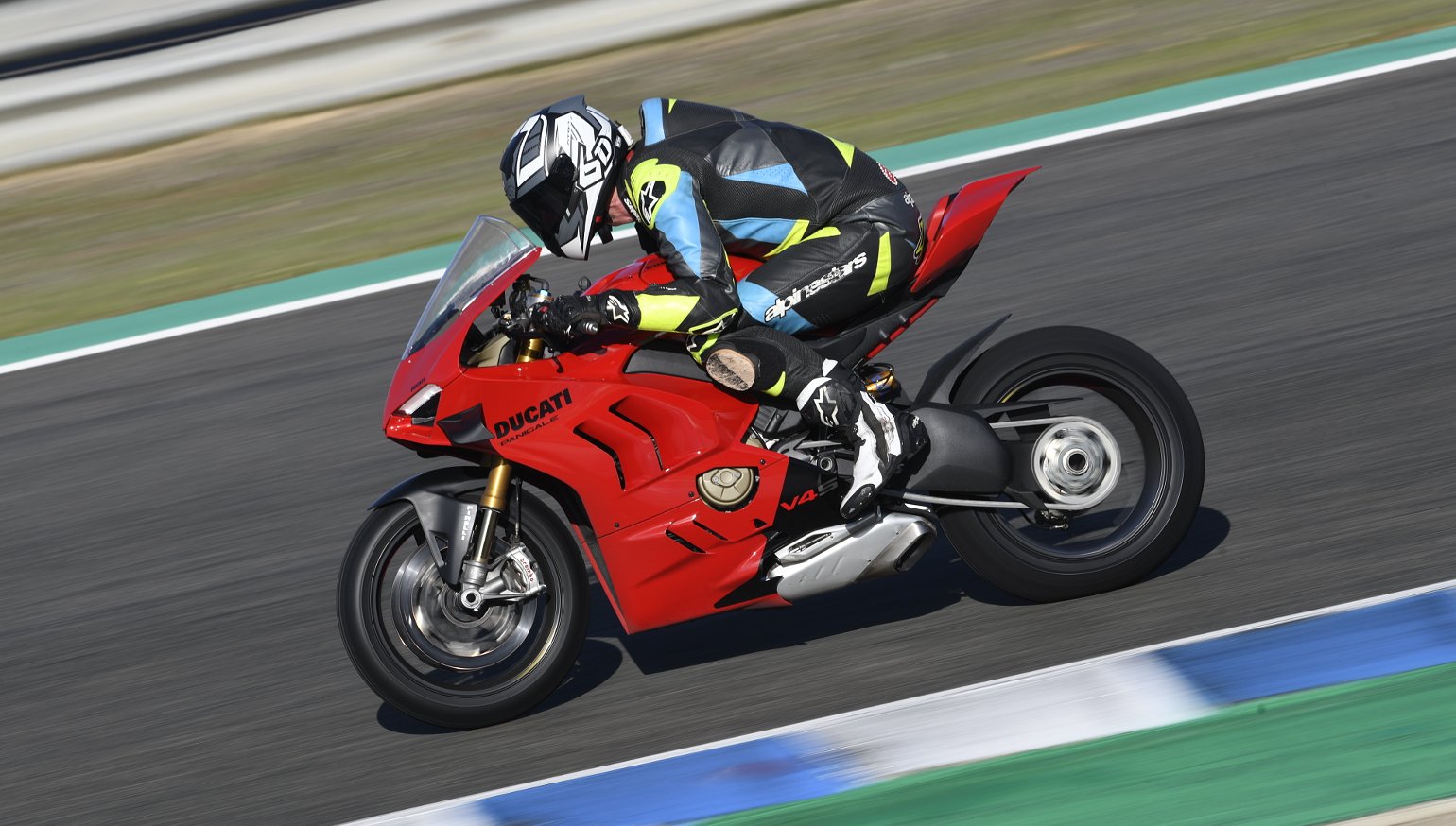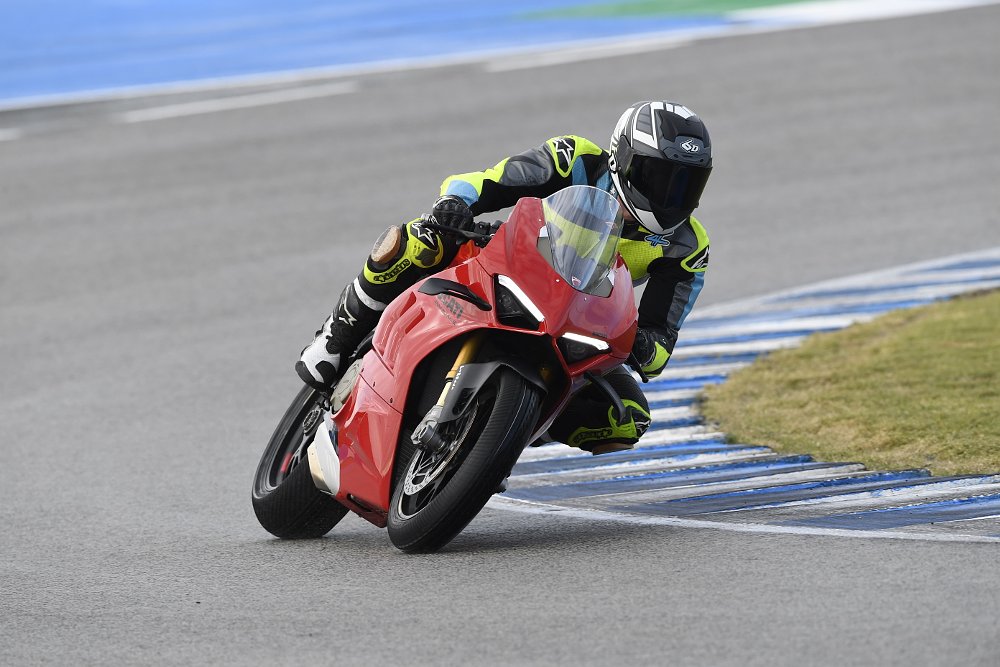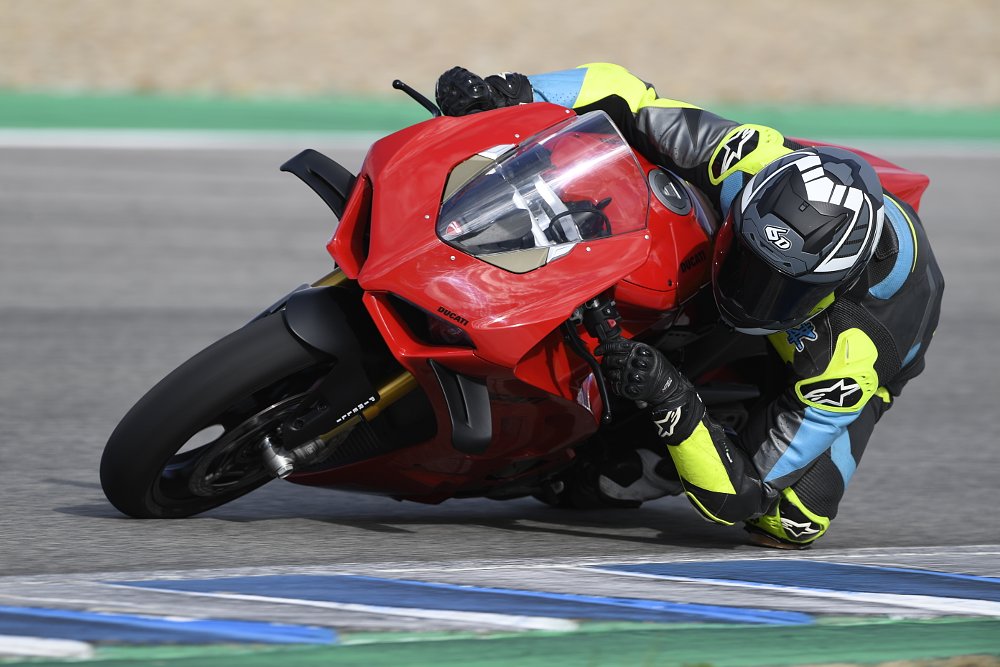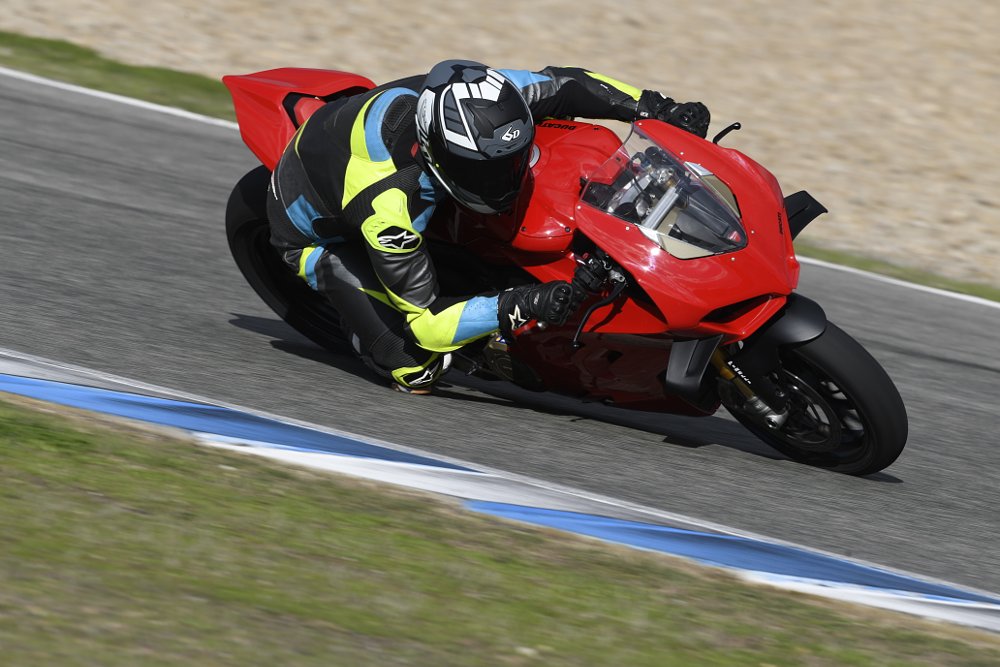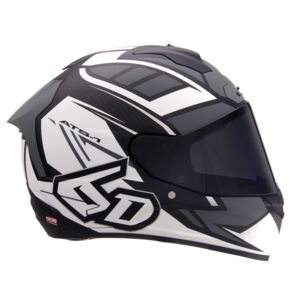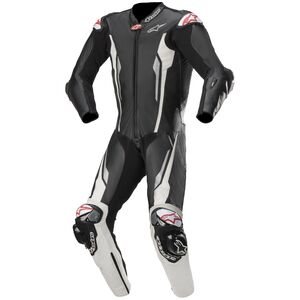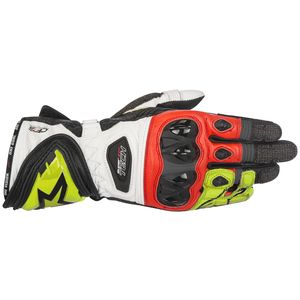Considering Ducati’s Panigale V4 is one of the fastest and most sophisticated motorcycles in the world, our relationship with the bike here at RevZilla is a little tense.
In 2019, Ari and I each had a chance to try the R version and agreed it was one of the sharpest track weapons either of us had ever tested. Last year, Ari had his face fairly melted by the V4 Superleggera. Then again, just a couple of months after that we tested the S model against a geriatric (albeit well prepared) Suzuki GSX-R1000 and had our faces melted in a different way, as Dave the Gixxer more than matched the exotic Italian's lap times. The pedigree of Ducati superbikes has always been clear, but suddenly the practical result was questionable.
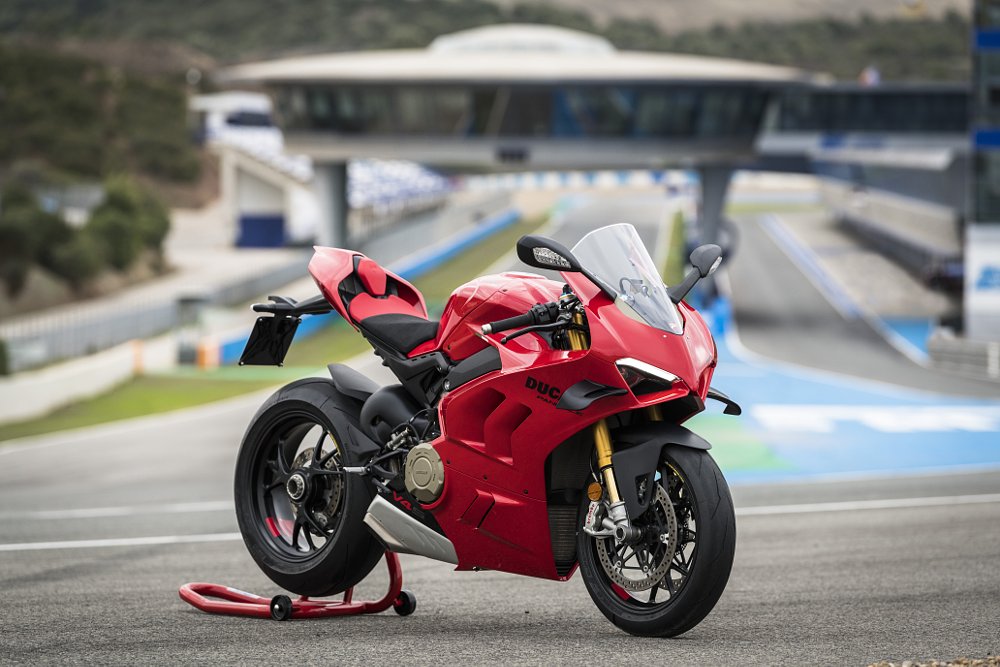
Hugely powerful bikes are inherently difficult to manage at full steam, which is why most of the companies in the fight for the fastest motorcycles in the world have been trying, to some extent, to make them easier to ride. Sometimes this is through electronics and software, but manufacturers that are serious about taming vicious power often look for mechanical solutions, as well.
The 2022 Panigale V4 incorporates both kinds of changes with the goal of making it work even better on the track, and working with less effort. But these changes are subtle, even invisible at first, in most cases: a few millimeters here, a percent or two there. So I packed my leathers and boots alongside my complicated history with the Panigale and flew off to Circuito de Jerez Ángel Nieto to learn more about the bike and sample Ducati's changes.
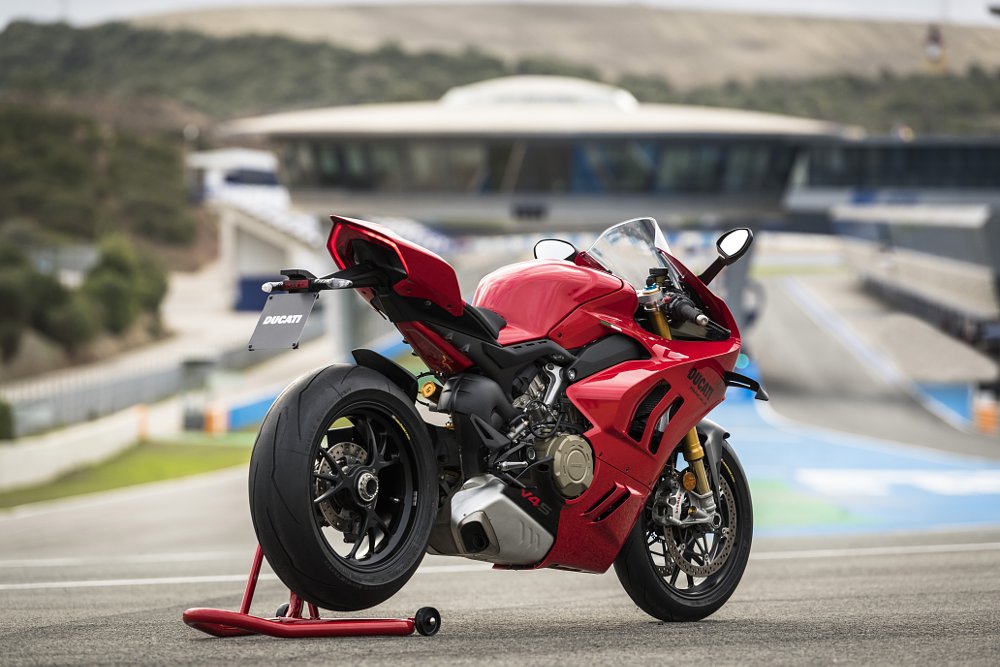
Updated tech
To start with the most prominent and superficial features, the Panigale’s winglets are smaller for 2022 while providing the same amount of downforce at speed. As much as 81 pounds at 186 mph and, maybe more realistically for those of us riding at less than 300 kph, about nine pounds at 60 mph. More vents in the fairing are designed to increase airflow to the cooling system, the seat is flatter at the back for less forward pitch, and the gas tank has a slightly broader shape near the seat, which happens to add 0.26 gallons of fuel capacity.
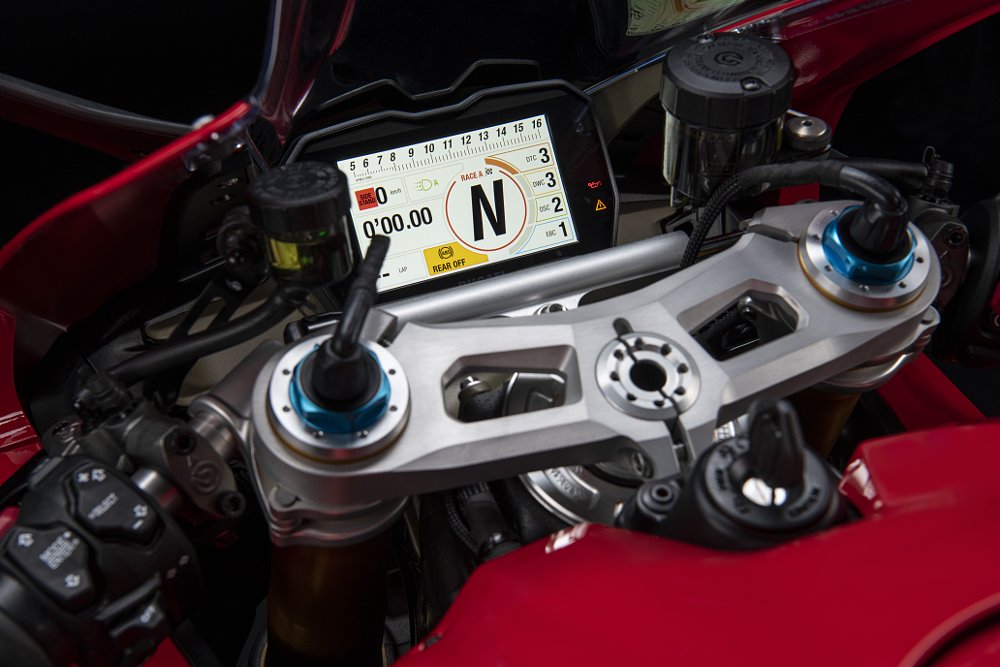
Not as obvious to the naked eye, but equally mechanical, the swingarm pivot has been raised four millimeters while the transmission’s internal ratios have been lengthened for first gear (11.6 percent) and second gear (5.6 percent) for smoother shifting and more usable ratios in slow corners on a race track. Sixth gear is also a hair taller (1.8 percent) for a claimed increase in top speed of a few miles per hour. Those of you disappointed in the 2021 Panigale V4’s paltry straight-line speed, rejoice.
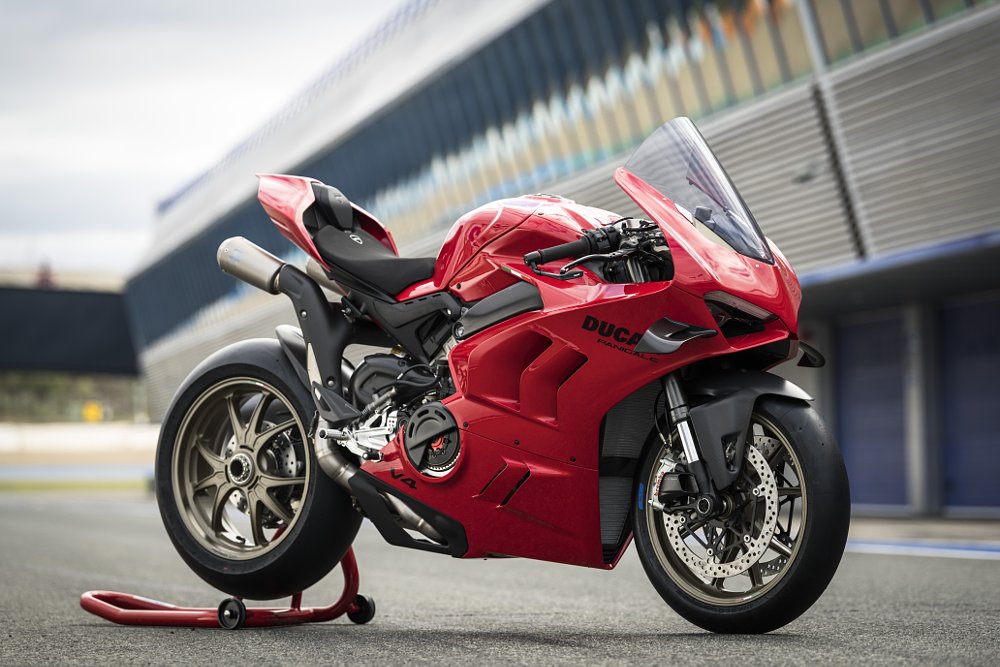
A gas-charged Öhlins NPX fork now graces the front end of the 2022 Panigale V4 and includes slightly softer springs and 0.2 inches more total wheel travel. The new fork works in tandem with an Öhlins TTX36 shock (not new for 2022) and both are plugged into Ducati’s standard “event-based” control system, meaning dynamic reactions to chassis behavior and tunability based on practical results — in other words, the rider can choose to add stability under braking, rather than adding clicks of compression damping to the fork. A fixed mode still allows for a rider to keep the system from making any dynamic adjustments while in motion and those damping schedules can be changed, via the dash, in numerical clicks.
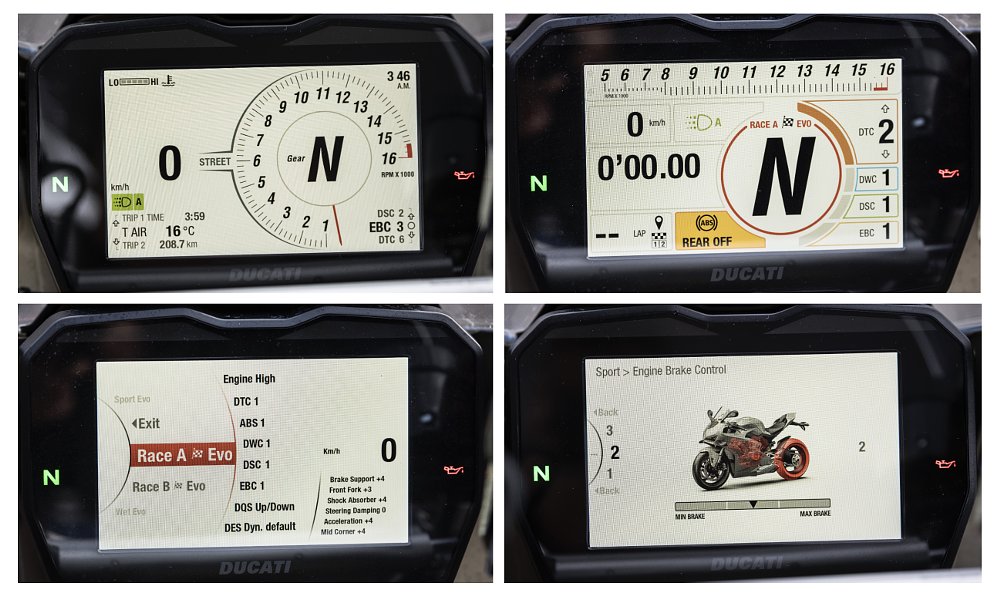
Before we veer off into the many, many (many) electronic systems on a state-of-the-art superbike, it’s worth noting that mechanically the Panigale V4’s 1,103 cc engine is largely the same. It is still a structural member of the motorcycle, with the rear subframe and swingarm bolting to the back and a front subframe connecting the engine to the fork. And, even though the Desmosedici Stradale mill in U.S. spec lost a bit of power for 2022 due to noise emissions regulations, it still puts out an imperial crap-ton of thrust — 210 horsepower and more than 90 foot-pounds of torque.
Some of the most significant work on this new version of the Panigale V4 took place on the engine maps. Ducati has sliced the available power delivery modes thinner than ever, with Low, Medium, High, and Full, and gone deeper than ever with different torque levels for each gear, depending on the ride mode selected. Y’see, offering different amounts of total power based on what gear is selected violates homologation regulations for vehicles used on public roads, I came to learn. However, evidently varying the torque curve is acceptable.
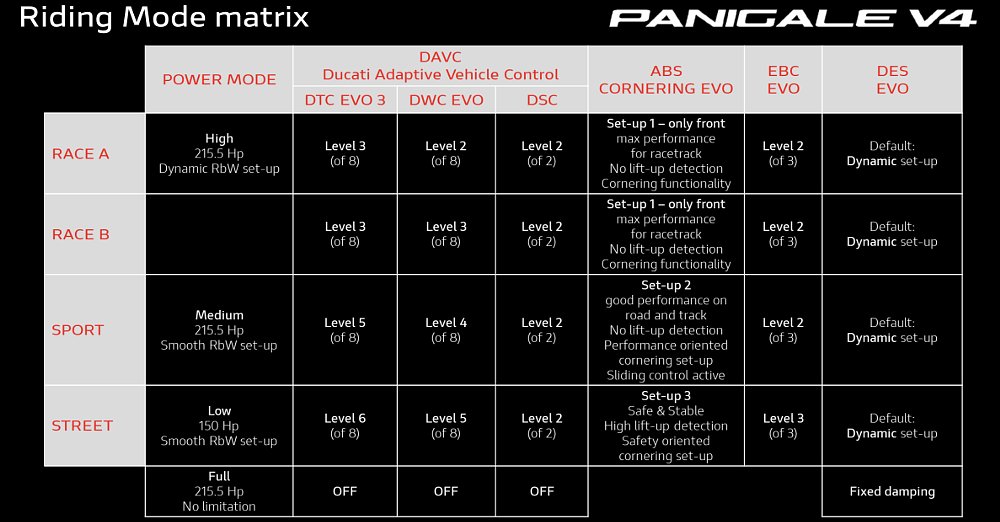
Previously, the engine limited torque equally in first and second gears, added a little more for third gear, and then used one additional (less intrusive) torque map to cover the upper three cogs in the transmission. As a part of the update, when in the Medium and High power maps, the bike sets slightly different (and increasing) torque parameters for every gear that is selected. The Low map caps power at 150 horsepower and is intended for use on the street or track time in the rain, while Full limits torque in first gear but otherwise delivers the maximum potential of the engine in every other gear.
Riding, divided
The subtlety of these updates to the Panigale V4 brings into focus just how complex the machine is and how microscopic the problems are that Ducati is trying to address. On the other hand, the wider view of the changes is simple: The company wants the bike to be easier to ride for anyone who tries it. In an interesting twist of fate, my testing on this new bike ended up split into two wet sessions (on racing rain tires) and three dry sessions on slicks. It was unusual and lucky. Piloting a motorcycle on a wet race track is tricky no matter how it’s sliced and it only gets harder with more horsepower.
It shouldn’t come as a huge surprise that the Ducati staff were insistent that the first session of rain riding was tackled in the Low power map with all of the rider aids — traction control, slide control, wheelie control, engine braking, and cornering ABS — dialed up. Less horsepower usually makes a motorcycle’s handling and brakes feel better by comparison and this was a case in point. It sounds dumb to call 150 horsepower “low,” but truth be told this Panigale felt tame and smooth on a wet track and I found myself at wide-open throttle early and often.
Incidentally, racing rain tires are magical things, and the grip at the world-class Jerez Circuit was very good. Exhibit A: MotoGP rider Jorge Martín was in attendance and passed me on another Panigale V4 approaching the fast left-hand turn eight, then proceeded to drag his elbow mid corner, a tail of water spraying off his tires. Aside from the massive slice of humble pie served up by Señor Martín, my confidence was high, and against Ducati’s recommendations I tried the High power map in the second session. It was more hectic, but still manageable.
With the track dry and slick tires mounted, the first afternoon session immediately felt like turning the speed of an arcade game up by about 50 percent. Suddenly, corners were flying at me like Major-League fastballs and where most of my inputs to the throttle and brakes in the morning had been measured and careful, on a dry surface I was relying on instinct to keep up the pace. I tried Medium, High, and Full engine maps, each of the three levels of wheelie control, three levels (eight available) of traction control, two levels (three available) of engine braking, and both the fixed and dynamic settings of the electronically controlled suspension.
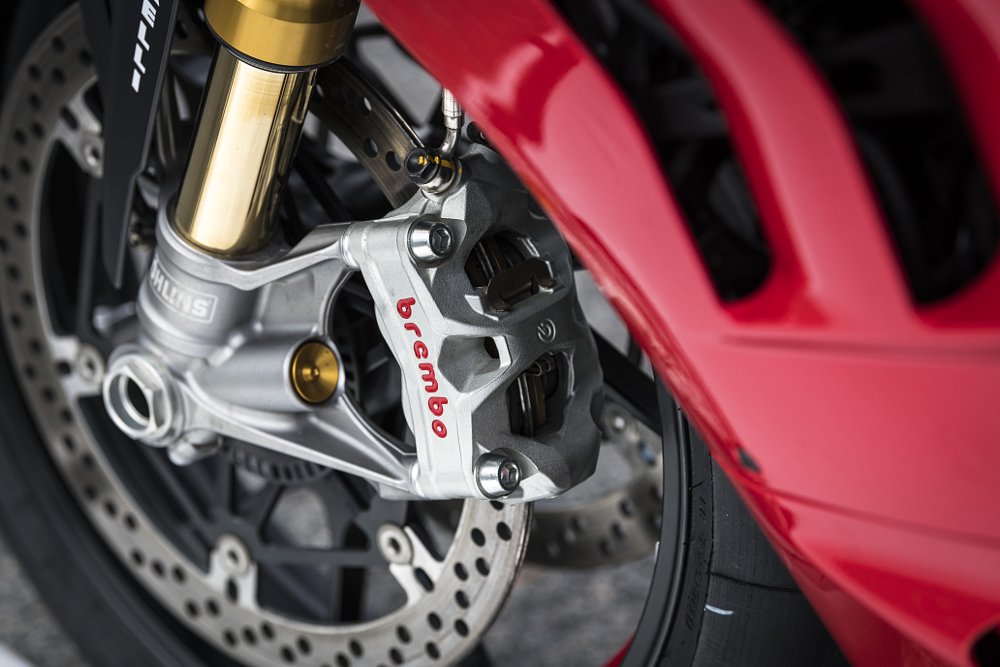
It was hard to find a fault in the Panigale V4’s attitude or ability on the track. Handling was sharp and predictable, the bike changed directions quickly, and I trusted the front end to stick while bailing toward an apex. The taller gearing was definitely helpful in smoothing the shifts in the lower half of the transmission, and I used first gear more readily because of it. I only used fifth gear for a couple of seconds per lap, never mind sixth. The flatter seat was hard to judge, but the fuel tank’s more vertical flanks did offer me more grip on the bike with my legs. My fastest lap (as far as I know) came with the engine in High, but Medium was a close second since it offered slightly softer access to the bike’s 200 horses.
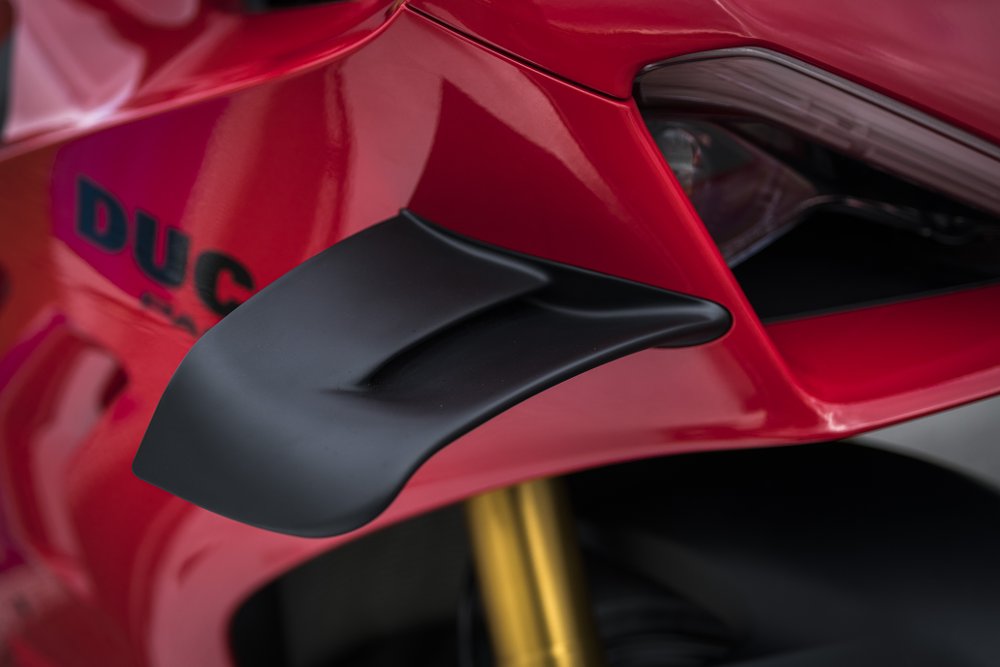
As for the changes to the seat, I appreciated the room afforded for my six-foot, two-inch frame to move back while braking and to tuck in on the straights, but in general found it hard to gauge or compare to the previous model. Is that bad? Part of me is embarrassed that I went all the way to Spain during a pandemic and couldn’t feel the difference in the seat. Mostly, I think we’re getting into the weeds of what this review is about.
The master plan
Looking deep within, I can’t help but be suspicious of my own good feelings about this bike, especially keeping in mind our history. The first time I rode the Panigale V4 (on a dry race track) in January of 2018 I recall thinking that it was noticeably easier to ride than the 1199 or 1299 versions of the Panigale and therefore a huge step forward. But my most recent experience with the V4 S in the making of the CTXP video sapped my confidence — I had none of the usual front-end feel, plus poor grip from the rear tire while accelerating, and that led to a surprising track-day defeat at the hands of a 15-year-old GSX-R1000. What gives?
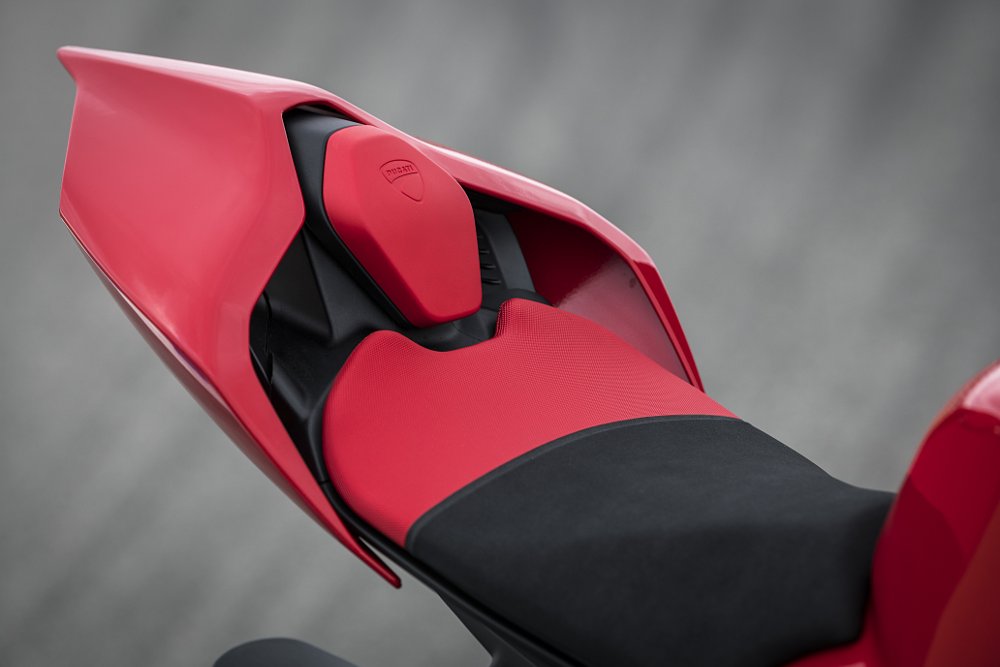
Did the updated fork and raised swingarm pivot on the 2022 Panigale V4, along with the slew of changes to software, make all the difference? It could be. Did Ducati’s test at Jerez prior to my arrival allow the team to set the bikes up perfectly for the track? That probably didn’t hurt. I’ll admit it seems fishy to be so impressed with a bike that only received a handful of updates since disappointing me, but I’ve looked for holes in my logic and haven’t come up with anything else worth sharing.
At the end of a day at Jerez, rain and shine, Low power to Full, I felt more ready to turn laps in anger than any motorcycle in a long time. The last showroom superbike that inspired me this much was Yamaha’s 2015 R1, which is a bike I did end up racing in stock trim and it was, in fact, good.
Putting aside my existential relationship crisis with the Panigale V4, I think what Ducati has done with this update is smart. Initially, I found it completely absurd that Bologna would bother to make a 214-horsepower superbike with wings even more track-oriented. A taller first gear, really? Why bother, when as it stands the prestige and pedigree of the brand carries so much weight and leaving stop signs is already tedious?
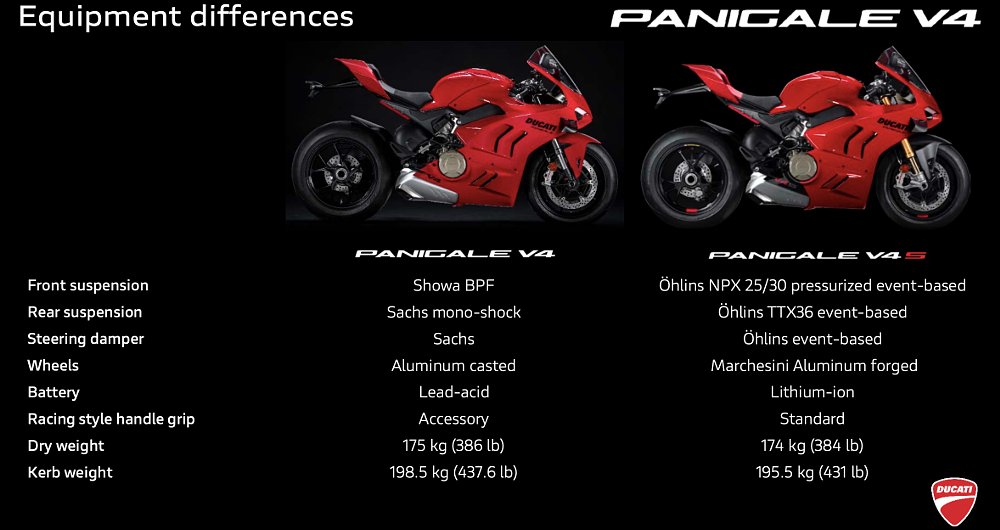
The opinion seems to be that for 30,000 bucks a customer should get all of what the company can offer, and that includes the proclivities of the test riders, however nuanced and miniscule the updates seem at first blush. And yes, if you must have it, Ducati will sell you a base model for $23,295 with a Sachs and Showa suspension, a single-color seat, and cast aluminum wheels.
So, again, why all of this pomp and circumstance to stretch a tiny bit closer to perfection? Because it’s what the people want, dammit. It’s the reason Ducati’s prestige exists in the first place. Because comfort and compromise do not make for exotica. Even if my relationship with the Panigale V4 has been iffy now and again, there’s no machine quite like it.
| 2022 Ducati Panigale V4 S (and base model) | |
|---|---|
| Price (MSRP) | $29,995 ($23,295) |
| Engine | 1,103 cc, liquid-cooled, 16-valve, V-four |
|
Transmission, final drive |
Six-speed, chain |
| Claimed horsepower | 210 @ 12,500 rpm |
| Claimed torque | 90.6 foot-pounds @ 11,000 rpm |
| Frame | Aluminum twin spar |
| Front suspension | Öhlins NPX25/30 43 mm fork, adjustable for spring preload, electronically adjustable for compression and rebound damping; 4.9 inches of travel (Showa 43 mm BPF, adjustable for spring preload, compression and rebound damping; 4.7 inches of travel) |
| Rear suspension | Öhlins TTX36 shock, adjustable for spring preload, electronically adjustable for compression and rebound damping; 5.1 inches of travel (Sachs shock, adjustable for spring preload, compression and rebound damping; 5.1 inches of travel) |
| Front brake | Brembo Stylema M4.30 four-piston calipers, 330 mm discs with ABS |
| Rear brake | Brembo two-piston caliper, 245 mm disc with ABS |
| Rake, trail | 24.5 degrees, 3.94 inches |
| Wheelbase | 57.8 inches |
| Seat height | 33.5 inches |
| Fuel capacity | 4.49 gallons |
| Tires | Pirelli Supercorsa SP; 120/70 ZR17 front, 200/60 ZR17 rear |
| Claimed weight | 431 pounds (437.6 pounds) |
| Available | February 2022 |
| Warranty | 24 months |
| More info | ducati.com |

 Membership
Membership

